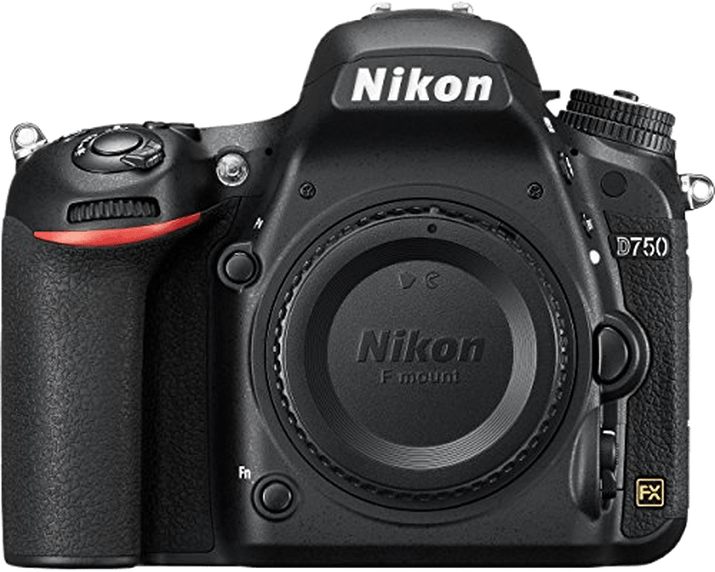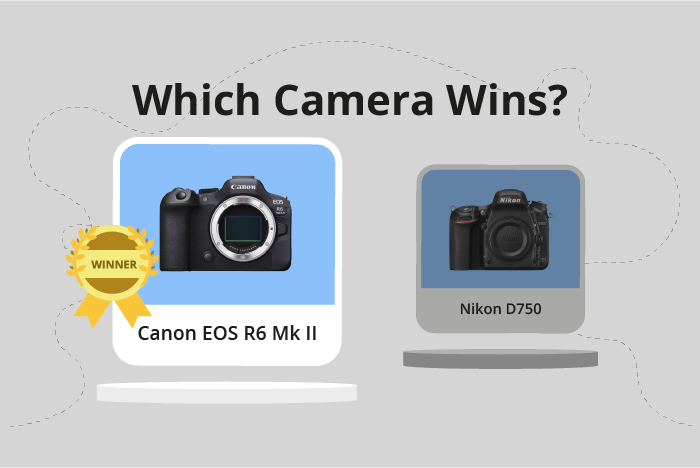Canon EOS R6 Mark II vs Nikon D750 Comparison
Canon EOS R6 Mark II

Nikon D750

The Canon EOS R6 Mark II tops the Nikon D750 with a score of 78/100 compared to 68/100. Both cameras are similar in size, with the Canon being slightly lighter at 588g compared to the Nikon’s 750g. Both were launched at a similar price point, with the Canon priced at $2499 and the Nikon at $2300.
The Canon’s higher score comes from its mirrorless design, offering a more compact and lightweight camera. Additionally, the Canon EOS R6 Mark II is a newer model, released in 2022, compared to the Nikon D750’s release in 2014. This gives the Canon an edge in terms of technology and features.
On the other hand, the Nikon D750, being a DSLR, may appeal to photographers who prefer a more traditional camera design. Despite its lower score, the Nikon still has a solid performance and remains a viable option for photographers.
Taking these factors into account, the Canon EOS R6 Mark II is the better camera due to its mirrorless design, lighter weight, and newer technology. However, the Nikon D750 may still be a suitable choice for those who prefer a DSLR camera.
Canon EOS R6 Mark II vs Nikon D750 Overview and Optics
The Canon EOS R6 Mark II outperforms the Nikon D750 in optics with a score of 83/100 compared to 71/100. Both cameras have a 24-megapixel CMOS sensor, full-frame sensor size, and similar megapixel counts. However, the Canon EOS R6 Mark II surpasses the Nikon D750 in several aspects.
The Canon EOS R6 Mark II has a higher shooting speed of 40 compared to the Nikon D750’s 6.5. This allows the Canon camera to capture fast-moving subjects with ease. Additionally, the Canon EOS R6 Mark II features a more advanced Digic X processor, resulting in faster image processing and improved overall performance. The camera also has a Canon RF lens mount, providing access to a wide range of high-quality lenses designed specifically for the Canon system.
One of the most significant advantages of the Canon EOS R6 Mark II is its image stabilization feature. This allows photographers to capture sharper images in low light conditions and reduces the likelihood of camera shake affecting image quality. The Nikon D750 does not have this feature.
Despite its lower score, the Nikon D750 has a slightly higher DXOMARK sensor score of 93 compared to the Canon EOS R6 Mark II’s 91. This indicates that the Nikon D750’s sensor performs marginally better in terms of overall image quality. The Nikon D750 also uses the Nikon F FX lens mount, which supports a vast selection of lenses, including older Nikon lenses.
To conclude, the Canon EOS R6 Mark II is the superior camera in terms of optics due to its higher shooting speed, advanced processor, image stabilization, and Canon RF lens mount. However, the Nikon D750 remains a viable option for photographers who prioritize sensor performance and compatibility with a wide range of Nikon lenses.
Canon EOS R6 Mark II vs Nikon D750 Video Performance
The Canon EOS R6 Mark II outperforms the Nikon D750 in video capabilities with a significant difference of 27 points, scoring 83/100 compared to the Nikon’s 56/100. Both cameras share some common specifications, such as a maximum video frame rate of 60fps, which ensures smooth video recording in both models.
The Canon EOS R6 Mark II’s superiority is evident in its higher maximum video resolution of 4K (3840 x 2160) compared to the Nikon D750’s Full HD (1920 x 1080) resolution. This higher resolution allows the Canon camera to capture more detailed and sharper videos, providing better overall quality. Additionally, the Canon EOS R6 Mark II includes built-in time-lapse functionality, which is not available in the Nikon D750. This feature offers users more creative options when recording videos.
The Nikon D750, while falling short in comparison to the Canon EOS R6 Mark II, still offers decent video capabilities with its Full HD resolution and 60fps frame rate. However, its lack of built-in time-lapse functionality limits its versatility compared to the Canon model.
Considering the differences in video specifications between the two cameras, the Canon EOS R6 Mark II is clearly the superior choice for those prioritizing video capabilities, due to its higher resolution and added time-lapse feature. The Nikon D750 may still be suitable for users who are content with Full HD resolution and do not require time-lapse functionality in their video recording.
Canon EOS R6 Mark II vs Nikon D750 Features and Benefits
The Canon EOS R6 Mark II outperforms the Nikon D750 in features, with a score of 72/100 compared to the Nikon’s 59/100. Both cameras share some common specifications, including a flip screen and WIFI connectivity. However, the Canon EOS R6 Mark II has several advantages over the Nikon D750, making it a more feature-rich camera.
The Canon EOS R6 Mark II has a 3-inch touchscreen display with a resolution of 1,620,000 dots, while the Nikon D750 has a slightly larger 3.2-inch screen but without touchscreen functionality and a lower resolution of 1,229,000 dots. The touchscreen on the Canon EOS R6 Mark II offers a more intuitive user experience and higher resolution for better image preview and review.
Additionally, the Canon EOS R6 Mark II comes with built-in GPS and Bluetooth capabilities, which are absent in the Nikon D750. GPS functionality enables geotagging of photos, and Bluetooth allows for seamless connectivity with compatible devices.
On the other hand, the Nikon D750 has a larger screen size, which might appeal to some users. However, this advantage is not significant enough to outweigh the benefits of the Canon EOS R6 Mark II’s touchscreen and higher resolution.
In comparing the features of the Canon EOS R6 Mark II and the Nikon D750, the Canon model proves to be superior due to its touchscreen display, higher resolution, and additional connectivity options. The Nikon D750 falls short in these aspects, making the Canon EOS R6 Mark II a more appealing choice for photographers seeking a camera with advanced features.
Canon EOS R6 Mark II vs Nikon D750 Storage and Battery
The Nikon D750 outperforms the Canon EOS R6 Mark II in storage and battery with a score of 79/100, compared to the Canon’s 68/100. Both cameras have two memory card slots and accept SD, SDHC, and SDXC cards. However, the Canon EOS R6 Mark II is UHS-II compatible, offering faster read and write speeds.
The Nikon D750 excels in battery life, providing 1230 shots per charge with its EN-EL15 battery, significantly more than the Canon’s 360 shots using the LP-E6NH battery. On the other hand, the Canon EOS R6 Mark II has the advantage of USB charging, making it more convenient for on-the-go charging.
Despite the Canon’s UHS-II compatibility and USB charging, the Nikon D750’s superior battery life sets it apart in this comparison. Meanwhile, the Canon EOS R6 Mark II offers a few practical benefits but falls short in overall storage and battery performance.
Canon EOS R6 Mark II vs Nikon D750 – Our Verdict
Are you still undecided about which camera is right for you? Have a look at these popular comparisons that feature the Canon EOS R6 Mark II or the Nikon D750:

